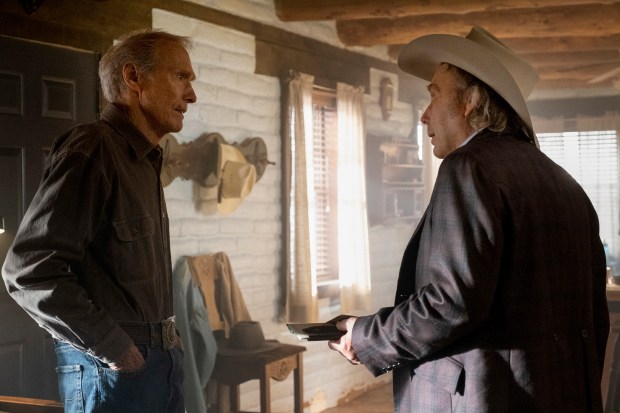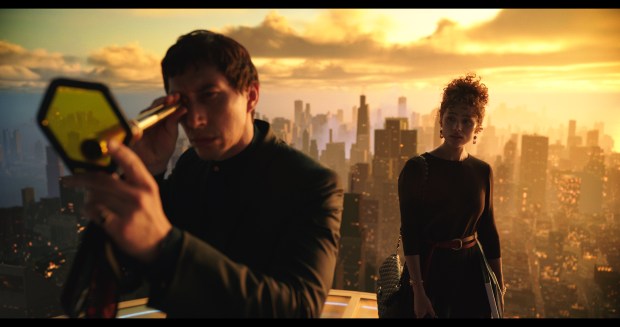Amid a tragically divided populace, one thing holds us together as a nation right now: the near-unanimous spite regarding a couple of flops, “Megalopolis” from Francis Ford Coppola and “Joker: Folie à Deux,” the “Joker” sequel starring Joaquin Phoenix and Lady Gaga.
Decades in the making, writer-director Coppola’s passion project arrived as an alien incursion from a more forgiving era in American film and filmgoing. “Megalopolis” recalls Coppola’s earlier Waterloo, the expensive and unpopular demi-musical “One From the Heart.” That one broke the back of the grand experiment known as American Zoetrope, the off-Hollywood, Bay Area studio founded in 1969 by Coppola and George Lucas. A bittersweet bookend to that movie, “Megalopolis” takes place in a Roman Empire-inspired vision of a corrupt and decadent New York City in desperate need of an urban design hero.
It’s so many things (miscast, naive, blithely misogynist, narratively blurry) and yet also so many other things (touching in its optimism, hypnotic in flashes, ardently operatic with a terrific, thundering musical score). It’s a ridiculous folly. And I’m glad it’s in the world, not out of any loyalty to Coppola’s body of work, but out of devotion to any film following some potentially untenable instincts, destination unknown.
It has been met by audiences both scant and largely baffled. Its ominous CinemaScore exit-poll rating of D+ added insult to injury and proved a pretty accurate predictor of its commercial fortunes. As of this week, “Megalopolis” has made $12 million worldwide, less than a tenth of its production budget.
“Joker: Folie à Deux” is a different, more ostensibly mainstream story. It follows the smash 2019 “Joker,” also directed by Todd Phillips. The sequel’s production budget landed somewhere between $175 million and $200 million, not counting marketing and distribution costs.
Whatever you think of it — I think it’s the only interesting film Phillips has ever made — it did not give the people what the people wanted. The first “Joker” was made on a relatively modest budget of less than $70 million, grossing more than $1 billion worldwide. People were in the mood then for a gut-grinding bummer, turning into surrogate vigilantes and rubberneckers for a couple of hours.
“Joker: Folie à Deux” asks more of its audience and plays like a sobered-up, sobering apology for the first one. Audience response: Huh? It only recently passed $165 million globally. The technical accounting term for that, I believe, is “terrible,” and the film’s D CinemaScore ranking was even harsher than the D+ handed to “Megalopolis.” This week Warner Bros. announced that “Joker 2” will be available Oct. 29 for digital streaming.
The numbers can’t lie. Can they? To much of Hollywood, including the unhappily amalgamated studio and streaming conglomerate Warner Bros. Discovery, the two most conspicuous commercial failures of the year represent all that is economically foolhardy in modern American cinema. One of those films, Coppola’s, is a self-financed outlier, while to many “Joker 2” is a different, star-driven example of creative arrogance without the impact of its predecessor.
As the hate rolled in for these two flops, I remembered a couple of truths. One: Money isn’t everything. Yes, the movies are a business but no one ever fell in love with the movies based on what they cost, or what they grossed.
Two: There’s more than one way to define a movie’s failure.
You know which 2024 movies I consider failures on a larger scale than either “Megalopolis” or “Joker: Folie à Deux”? Some of the year’s biggest financial successes: “Bad Boys: Ride or Die,” “Deadpool & Wolverine” and “Beetlejuice Beetlejuice.”
They’re successes by every measurement, except the ones that will mean something a few years from now: Things like filmmaking vitality. Fluidity of technique. Visual dynamism. The shock of the new.
These three sequels are failures because they bring so little to their genres, and to the popular art we love no matter how many mediocrities erode our interest and expectations. The action sequences in “Bad Boys: Ride or Die” are just visual noise, haphazardly patched together. The frenzied splatter of “Deadpool & Wolverine” works for millions of people, clearly. Your opinion’s worth something; mine, approximately the same.
For the theater owners of America, I’m glad those films made money. But even “Beetlejuice Beetlejuice,” a soulless rebuke to the freshness of the 1988 horror-screwball original, arrived overpacked with enough digital effects to put the comedy on afterlife support by the 20-minute mark.

For all its labor-intensive requirements, moviemaking remains a mysterious phenomenon. The screen industries have never been less stable or knowledgeable about their own survival strategies, and the people in charge take little comfort from the lessons of history, or the movie theaters’ regularly scheduled threats to their existence including pandemics, the Great Depression, “Texaco Star Theater” with Milton Berle, VCRs, DVDs, streaming and, you know, life.
Too many executives in charge dismiss that history, as well as loyalty, as irrelevant, especially to the stock price. Yet is that always true?
Take Clint Eastwood.
David Zaslav, the CEO and president of Warner Bros. Discovery, is dumping the new Clint Eastwood drama “Juror #2” in an estimated 50 theaters nationwide on Nov. 1. Fifty. Not 500. Fifty. In other words, forget the theater owners, we have a streaming service to service.
Eastwood is 94. For Warner Bros., he has directed 15 films in the last 20 years. The courtroom drama “Juror #2” makes it 16.
Some of those films have been huge popular successes, with “American Sniper” ($547 million worldwide) at the peak.

Clint Eastwood and Dwight Yoakam in a scene from “Cry Macho.” (Claire Folger/Warner Bros./AP)
Generally a movie need to make 2.5 or 3 times its budget to break even. Eastwood’s most recent film, “Cry Macho,” lost money, earning back only half of its $33 million budget.
But consider the long game: Eastwood made his last 20 years’ worth of feature projects for a production budget total of $665 million, financing 19 films. Those 19 films took in $2.22 billion in theaters.
In other words: They worked. The system worked. Eastwood made Warner Bros. money. The last two decades, on top of all the previous years, Eastwood’s Malpaso Productions and Warner Bros. did business together, paid off across best-picture Academy Award winners (“Unforgiven,” “Million Dollar Baby”), a sublime, unconventional World War II story told entirely in Japanese (“Letters from Iwo Jima”) and a cockeyed sort-of-true story about the world’s unlikeliest drug courier (“The Mule”).
Eastwood is not Coppola. He would never gamble $120 million of his own money on a movie like “Megalopolis,” though there is no other movie like “Megalopolis.” Nor is Eastwood like Todd Phillips, in any discernible respect. When Eastwood’s long-delayed adaptation of the novel “Cry Macho” didn’t do well, Zaslav told a Warner Bros. underling, in a phone call later leaked, that the studio had no business making it, period. Eastwood’s track record didn’t matter.
“We don’t owe anyone any favors,” Zaslav is reported to have said.
Three decades earlier, after the apparent financial failure of “A Perfect World” in 1993, Eastwood told the New York Times, paraphrasing a line from his film “White Hunter, Black Heart”: “You must forget anyone’s ever going to see the film you make. You must make it the best way you can, and not be distracted by what people say will make it appetizing for the public.”
Straight and plain, that’s as good a director’s credo as any, though seldom put into practice. And you know what? “A Perfect World,” director and co-star Eastwood’s plaintive, unconventional drama of child abduction and recovery, starring Kevin Costner? Even that turned a profit for Eastwood, and Warner Bros., in the end.
Maybe this is what appeals to me about the movies everyone’s trashing for sport. “Megalopolis” and “Joker 2” don’t give a damn. It sounds indefensible, amoral — a hundred or two hundred million, down the drain. But this industry’s reputation was made by prospectors, foolish and sometimes right, panning for something rarer than gold: a hit, even if it’s a flop, not like any other.
Phillips is a Tribune critic.



